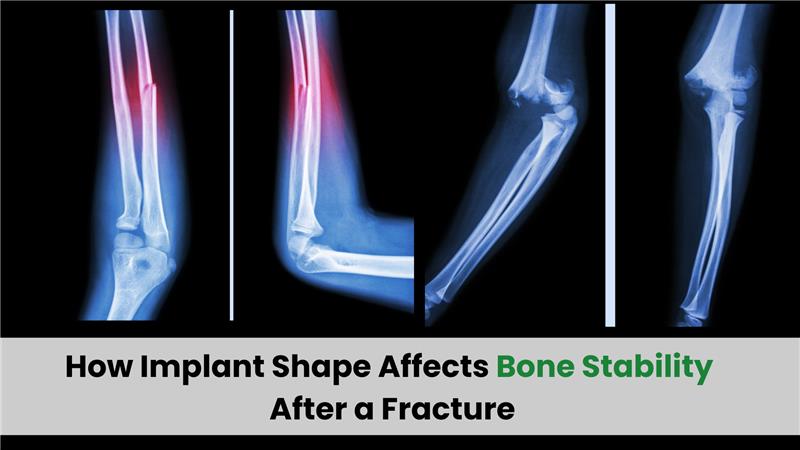Fractures, whether caused by trauma, osteoporosis, or accidents, compromise the integrity of bones and often require internal fixation to support recovery. In orthopedic surgery, implants like plates, screws, and rods play a crucial role in restoring bone alignment and function. However, not all implants are created equal. One of the most important—yet often overlooked—factors influencing the success of a fixation is implant shape.
From contoured plates that follow natural bone anatomy to specialized implants like the Locking T-Fix T-Plate, shape is vital in determining how effectively a bone remains stable throughout the recovery process. This article explores the importance of implant shape and how modern orthopedic designs optimize post-fracture outcomes.
The Role of Implant Shape in Bone recovery
Bone recovery is a complex biological process that demands mechanical stability. When a fracture occurs, orthopedic implants act as a bridge, holding the broken pieces in place so that natural recovery can proceed. The implant’s shape directly influences its mechanical performance, surgical fit, and long-term success.
Key impacts of implant shape include:
- Anatomical Compatibility: A well-shaped implant fits the bone contour, reducing gaps between the implant and bone surface.
- Stability and Load Transfer: The correct shape allows even distribution of forces across the fracture site.
- Minimized Soft Tissue Irritation: Low-profile or contoured designs avoid impingement on nearby muscles and tendons.
- Surgical Efficiency: Pre-contoured implants require less intraoperative bending, reducing surgery time and error.
Case in Focus: The Locking T-Fix T-Plate
A prime example of innovation in implant design is the Locking T-Fix T-Plate. Specifically engineered for distal radius fractures and certain long bone applications, this implant demonstrates how shape can drastically influence fracture management outcomes.
Key Features:
- T-Shaped Design: Matches the anatomy of the distal radius, ensuring perfect fit.
- Locking Mechanism: Offers angular stability which is crucial in osteoporotic or multi-fragmentary fractures.
- Low Profile: Minimizes soft tissue interference and post-operative discomfort.
- Multiple Screw Options: Allows customized screw placement to stabilize complex fracture patterns.
The shape of the Locking T-Fix T-Plate allows surgeons to restore natural bone curvature while ensuring rigid internal fixation—two key factors in promoting bone union.
Anatomical Matching: A Critical Design Principle
Human bones vary greatly in shape, curvature, and thickness depending on their location and function. For example:
- The femur has a natural arc to bear weight and support movement.
- The radius and ulna in the forearm are slender and slightly twisted.
- The pelvis is wide and irregular, supporting core body weight.
Effective implant shape design takes these variations into account. An implant that mimics natural bone geometry ensures better load-sharing, reduces implant stress, and minimizes the risk of post-operative complications.
Evolution in Implant Design
Earlier generations of implants were flat and generic, requiring surgeons to manually bend them during surgery. This not only increased surgery time but also compromised implant integrity. Today, pre-contoured implants like the Locking T-Fix T-Plate represent a shift toward anatomical precision and biomechanical alignment.
Modern innovations include:
- 3D modeling based on CT scans
- Computer-aided design (CAD) for precision contouring
- Patient-specific implants for unique anatomies
- Variable angle screw placement for flexibility
Such innovations ensure that implant shape not only supports bone recovery but also facilitates minimally invasive and accurate procedures.
Implant Shape and Post-Operative Outcomes
When implant shape aligns with bone structure, patients experience:
Faster recovery and rehabilitation
Lower risk of implant failure
Reduced need for revision surgery
Better cosmetic and functional outcomes
These benefits emphasize why orthopedic surgeons and manufacturers are investing heavily in implant design and anatomical compatibility.
The Manufacturing Perspective
With the growing demand for precise and durable orthopedic implants, manufacturers are focusing on advanced design and biomechanical testing. Companies specializing in trauma care products now incorporate technologies like CNC machining and 3D prototyping to develop implants like the Locking T-Fix T-Plate.
India, in particular, has emerged as a hub for quality implant production, with several top brands offering world-class designs at competitive prices. The focus is shifting from just “fixation” to functionally optimized recovery.
Conclusion
Implant shape is not just a design feature—it’s a functional necessity in ensuring bone stability after a fracture. From fitting the bone surface to distributing mechanical loads evenly, shape determines how well an implant performs inside the body. Advanced products like the Locking T-Fix T-Plate are revolutionizing fracture care by offering anatomically contoured, biomechanically sound solutions.
As orthopedic science continues to evolve, the future of fracture management will depend even more on precise implant design—where shape is not just form, but function.

